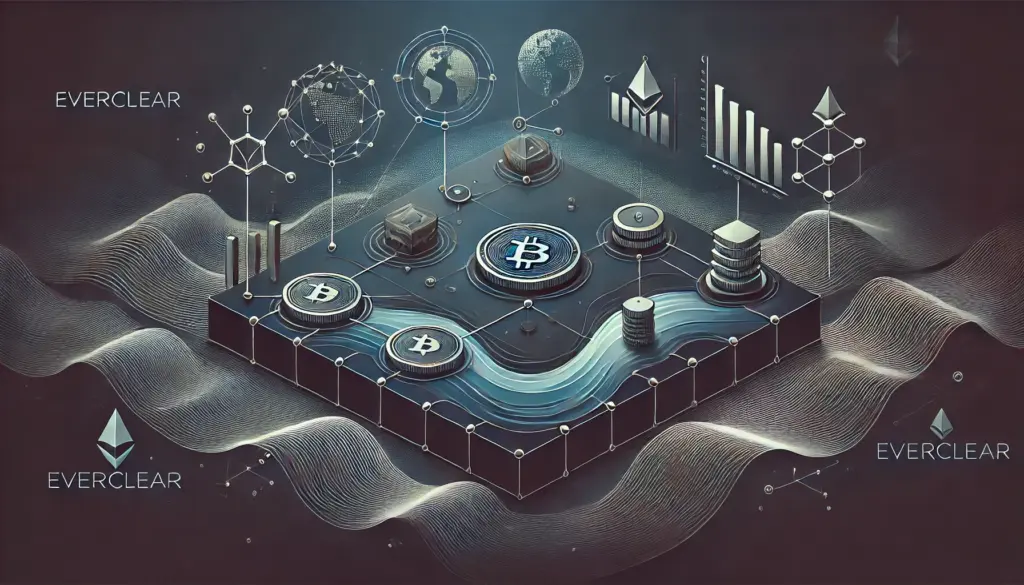Introduction to Everclear
Everclear is a pioneering protocol developed to enable intent-based transactions across multiple blockchain networks. Its core objective is to simplify the complexities of cross-chain transactions, making the transfer of data and assets between diverse blockchain ecosystems more seamless. As the blockchain industry continues to expand, efficient cross-chain transactions are becoming increasingly vital.
Key Features of Everclear
Streamlining Cross-Chain Interactions
Everclear facilitates intent-based transactions across various blockchain networks, eliminating the need for users to manage multiple transactions on different platforms. Moreover, the protocol streamlines these interactions through innovations like chain abstraction and modular design. Initially launched as Connext, Everclear evolved to address the growing demands of blockchain interoperability, offering a more sophisticated and scalable solution.
Understanding Everclear’s Functionality
Everclear functions as a “clearing layer,” addressing interoperability challenges by utilizing a three-pronged approach: socialized costs, a programmable layer, and permission-less expansion. Consequently, this framework enhances blockchain interoperability while promoting a more cohesive and efficient decentralized finance (DeFi) ecosystem. Notably, Everclear’s partnership with the Renzo Protocol further bolsters its capacity to facilitate the re-staking of staked ETH derivatives across different blockchains.
Evolution from Connext to Everclear
Addressing the Growing Complexity
Everclear originated as Connext, a blockchain solution focused on secure and efficient cross-chain communication and asset transfer. While Connext effectively tackled some foundational challenges, the rapid proliferation of new blockchain networks exposed its limitations, such as increased complexity, costs, and slower processing times. These challenges led to the creation of Everclear, a more advanced protocol designed to enhance Connext’s capabilities and address its shortcomings.
Achieving Scalability and Flexibility
Everclear positions itself as the first clearing layer to coordinate global netting and settlement of capital flows across various blockchains. It achieves scalability through advanced algorithms and architectures designed to manage high transaction volumes across multiple networks. For instance, Everclear reduces cross-chain transaction costs by socializing rebalancing expenses. Additionally, the introduction of a programmable layer offers flexibility, allowing users to create and deploy mechanisms for rebalancing and settling funds. Furthermore, Everclear supports permissionless expansion, enabling the integration of new blockchain networks without requiring central authority approval.
Addressing Liquidity Fragmentation
The Challenge of Fragmented Liquidity
Liquidity is crucial in decentralized finance, referring to how easily an asset can be converted into cash without affecting its market value. However, as the DeFi sector grows, challenges like liquidity fragmentation arise. Liquidity fragmentation occurs when liquidity is dispersed across multiple venues, platforms, or blockchains. Due to limited interoperability, liquidity becomes scattered, hindering seamless transactions and reducing market efficiency.
Impact of Liquidity Fragmentation
The consequences of liquidity fragmentation are significant. First, it can lead to price discrepancies, where the same asset has different prices on various exchanges. This creates arbitrage opportunities but also highlights the need for consistent pricing. Second, fragmented liquidity increases volatility and slippage, making large trades more disruptive and discouraging market participation. Moreover, low liquidity environments are susceptible to market manipulation, undermining market integrity. Lastly, fragmented liquidity weakens market depth, leading to larger bid-ask spreads and reducing the market’s overall attractiveness.
Everclear’s Solution to Liquidity Fragmentation
Enabling Seamless Transfers
Everclear addresses liquidity fragmentation by enabling the seamless transfer of data and assets between blockchain networks. It implements strategies such as socializing rebalancing costs and netting settlements. By aggregating multiple transactions and settling them in bulk, Everclear reduces transaction costs and enhances efficiency.
How Everclear Works
Everclear simplifies cross-chain transactions through a combination of chain abstraction and modularity. This allows users to focus on desired outcomes without dealing with technical complexities. Its intent-based architecture ensures efficient, secure, and scalable operations across multiple blockchain networks.
Key Components of Everclear
Intents-Based Architecture
Users express their desired actions on different blockchains, and service providers handle the complexities of execution, optimizing for the best price. As a result, Everclear abstracts cross-chain transaction details, providing users with a straightforward interface while service providers manage the technical tasks.
Chain Abstraction and Modularity
Everclear’s modular design separates functions into distinct layers, enabling easy integration with various blockchains and enhancing scalability. This design allows Everclear to focus on optimizing the clearing and netting processes while relying on specialized infrastructures for other aspects.
Transforming Blockchain Interactions
Everclear is revolutionizing the blockchain landscape by addressing liquidity fragmentation, a significant challenge in the DeFi space. By streamlining cross-chain transactions, Everclear reduces complexity and improves efficiency, allowing users to focus on strategic tasks. As the blockchain industry evolves, cross-chain solutions like Everclear will become crucial for ensuring seamless interactions across decentralized ecosystems.




